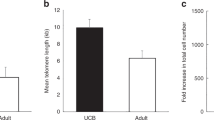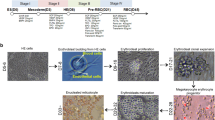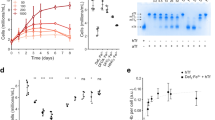Abstract
New sources of red blood cells (RBCs) would improve the transfusion capacity of blood centers. Our objective was to generate cells for transfusion by inducing a massive proliferation of hematopoietic stem and progenitor cells, followed by terminal erythroid differentiation. We describe here a procedure for amplifying hematopoietic stem cells (HSCs) from human cord blood (CB) by the sequential application of specific combinations of growth factors in a serum-free culture medium. The procedure allowed the ex vivo expansion of CD34+ progenitor and stem cells into a pure erythroid precursor population. When injected into nonobese diabetic, severe combined immunodeficient (NOD/SCID) mice, the erythroid cells were capable of proliferation and terminal differentiation into mature enucleated RBCs. The approach may eventually be useful in clinical transfusion applications.
This is a preview of subscription content, access via your institution
Access options
Subscribe to this journal
Receive 12 print issues and online access
$209.00 per year
only $17.42 per issue
Buy this article
- Purchase on Springer Link
- Instant access to full article PDF
Prices may be subject to local taxes which are calculated during checkout





Similar content being viewed by others
References
Eliason, J.F., Testa, N.G. & Dexter, T.M. Erythropoietin-stimulated erythropoiesis in long-term bone marrow culture. Nature 281, 382–384 (1979).
Dexter, T.M., Testa, N.G., Allen, T.D., Rutherford, T. & Scolnick, E. Molecular and cell biologic aspects of erythropoiesis in long-term bone marrow cultures. Blood 58, 699–707 (1981).
Malik, P. et al. An in vitro model of human red blood cell production from hematopoietic progenitor cells. Blood 91, 2664–2671 (1998).
Panzenböck, B., Bartunek, P., Mapara, M.Y. & Zenke, M. Growth and differentiation of human stem cell factor/erythropoietin-dependent erythroid progenitor cells in vitro. Blood 92, 3658–3668 (1998).
Freyssinier, J.M. et al. Purification, amplification and characterization of a population of human erythroid progenitors. Br. J. Haematol. 106, 912–922 (1999).
von Lindern, M. et al. The glucocorticoid receptor cooperates with the erythopoietin receptor and c-kit to enhance and sustain proliferation of erythroid progenitors in vitro. Blood 94, 550–559 (1999).
Chelucci, C. et al. In vitro human immunodeficiency virus-1 infection of purified hematopoietic progenitors in single-cell culture. Blood 85, 1181–1187 (1995).
Southcott, M.J., Tanner, M.J. & Anstee, D.J. The expression of human blood group antigens during erythropoiesis in a cell culture system. Blood 93, 4425–4435 (1999).
Metcalf, D. Hematopoietic regulators: redundancy or subtlety? Blood 82, 3515–3523 (1993).
Alexander, W.S., Roberts, A.W., Nicola, N.A., Li, R. & Metcalf, D. Deficiencies in progenitor cells of multiple hematopoietic lineages and defective megakaryocytopoiesis in mice lacking the thrombopoietic receptor c-Mpl. Blood 87, 2162–2170 (1996).
Young, J.C. et al. Thrombopoietin stimulates megakaryocytopoiesis, myelopoiesis, and expansion of CD34+ progenitor cells from single CD34+Thy-1+Lin− primitive progenitor cells. Blood 88, 1619–1631 (1996).
Muta, K., Krantz, S.B., Bondurant, M.C. & Dai, C.H. Stem cell factor retards differentiation of normal human erythroid progenitor cells while stimulating proliferation. Blood 86, 572–580 (1995).
Koury, M.J. & Bondurant, M.C. The molecular mechanism of erythropoietin action. Eur. J. Biochem. 210, 649–663 (1992).
Sawada, K. et al. Purification of human blood burst-forming units–erythroid and demonstration of the evolution of erythropoietin receptors. J. Cell. Physiol. 142, 219–230 (1990).
Boyer, S.H. et al. Roles of erythropoietin, insulin like growth factor I, and unidentified serum factors in promoting maturation of purified murine erythroid colony forming units. Blood 80, 2503–2512 (1992).
Sawada, K., Krantz, S.B., Dessypris, E.N., Koury, S.T. & Sawyer, S.T. Human colony forming units erythroid do not require accessory cells, but do require direct interaction with insulin like growth factor I and/or insulin for erythroid development. J. Clin. Invest. 83, 1701–1709 (1989).
Muta, K., Krantz, S.B., Bondurant, M.C. & Wickrema, A. Distinct roles of erythropoietin, insulin-like growth factor I, and stem cell factor in the development of erythroid progenitor cells. J. Clin. Invest. 94, 34–43 (1994).
Majka, M. et al. The role of HIV-related chemokine receptors and chemokines in human erythropoiesis in vitro. Stem Cells 18, 128–138 (2000).
Okumura, N., Tsuji, K. & Nakahata, T. Changes in cell surface antigen expressions during proliferation and differentiation of human erythroid progenitors. Blood 80, 642–650 (1992).
Papassotiriou, I., Ducrocq, R., Préhu, C., Bardakdjian-Michau, J. & Wajcman, H. Gamma chain heterogeneity: determination of Hb F composition by perfusion chromatography. Hemoglobin 22, 469–481 (1998).
Lyons, A.B. & Parish, C.R. Determination of lymphocyte division by flow cytometry. J. Immunol. Methods 171, 131–137 (1994).
Bony, V., Gane, P., Bailly, P. & Cartron, J.P. Time-course expression of polypeptides carrying blood group antigens during human erythroid differentiation. Br. J. Haematol. 107, 263–274 (1999).
Zanjani, E.D., McGlave, P.B., Bhakthavathsalan, A. & Stamatoyannopoulos, G. Sheep fetal haematopoietic cells produce adult haemoglobin when transplanted in the adult animal. Nature 280, 495–496 (1979).
Larochelle, A. et al. Engraftment of immune-deficient mice with primitive hematopoietic cells from β-thalassemia and sickle cell anemia patients: implications for evaluating human gene therapy protocols. Hum. Mol. Genet. 4, 163–172 (1995).
Samakoglu, S. et al. β-minor-globin messenger RNA accumulation in reticulocytes governs improved erythropoiesis in β-thalassemic mice after erythropoietin complementary DNA electrotransfer in muscles. Blood 97, 2213–2220 (2001).
Le Van Kim, C. et al. PCR-based determination of Rhc and RhE status of fetuses at risk of Rhc and RhE haemolytic disease. Br. J. Haematol. 88, 193–195 (1994).
Kobari, L. et al. In vitro and in vivo evidence for the long term multilineage (myeloid, B, NK and T) reconstitution capacity of ex vivo expanded CD34+ cord blood cells. Exp. Hematol. 28, 1470–1480 (2000).
Giarratana, M.C. et al. Cell culture bags allow high extent of ex vivo expansion of LTC-IC and functional mature cells which can subsequently be frozen: interest for large scale clinical applications. Bone Marrow Transplant. 22, 707–715 (1998).
Hentzen, E.R. et al. Sequential binding of CD11a/CD18 and CD11b/CD18 defines neutrophil capture and stable adhesion to intercellular adhesion molecule-1. Blood 95, 911–920 (2000).
Lewis, D.E. et al. Rare event selection of fetal nucleated erythrocytes in maternal blood by flow cytometry. Cytometry 23, 218–227 (1996).
Pic, P., Ducrocq, R. & Girot, R. Séparation des hémoglobines F, Fac, S, C, A1c et dosage de l'hémoglobine F par chromatographie liquide haute performance. Ann. Biol. Clin. 52, 129–132 (1994).
Marden, M.C., Kister, J., Bohn, B. & Poyard, C. T-state hemoglobin with four ligands bound. Biochemistry 27, 1659–1664 (1988).
Acknowledgements
The authors thank B. Drayton, M. Adam, J. Van Nifterik, A. Yapo, R. Gilot, and the cytometry team of Armand Trousseau Hospital for technical assistance, P. Gane for the gift of RhD antibodies, and Y. Brossard, P. Rouyer-Fessard, and Y. Bezard for helpful discussions. We are also grateful to M. Ardouin for the valuable gift of NOD/SCID mice. This work was supported by grants from the Association pour la Recherche en Transfusion, the Etablissement Français des Greffes, and La Ligue Contre le Cancer. T.M.A.N.-N. received a grant from the Association Combattre la Leucémie.
Author information
Authors and Affiliations
Corresponding author
Rights and permissions
About this article
Cite this article
Neildez-Nguyen, T., Wajcman, H., Marden, M. et al. Human erythroid cells produced ex vivo at large scale differentiate into red blood cells in vivo. Nat Biotechnol 20, 467–472 (2002). https://doi.org/10.1038/nbt0502-467
Received:
Accepted:
Issue Date:
DOI: https://doi.org/10.1038/nbt0502-467
This article is cited by
-
Detection of CRISPR/Cas9-Mediated Fetal Hemoglobin Reactivation in Erythroblasts Derived from Cord Blood-Hematopoietic Stem Cells
Molecular Biotechnology (2024)
-
Generating hematopoietic cells from human pluripotent stem cells: approaches, progress and challenges
Cell Regeneration (2023)
-
Ferric citrate and apo-transferrin enable erythroblast maturation with β-globin from hemogenic endothelium
npj Regenerative Medicine (2023)
-
Recent updates of stem cell-based erythropoiesis
Human Cell (2023)
-
Induction of enucleation in primary and immortalized erythroid cells
International Journal of Hematology (2022)



